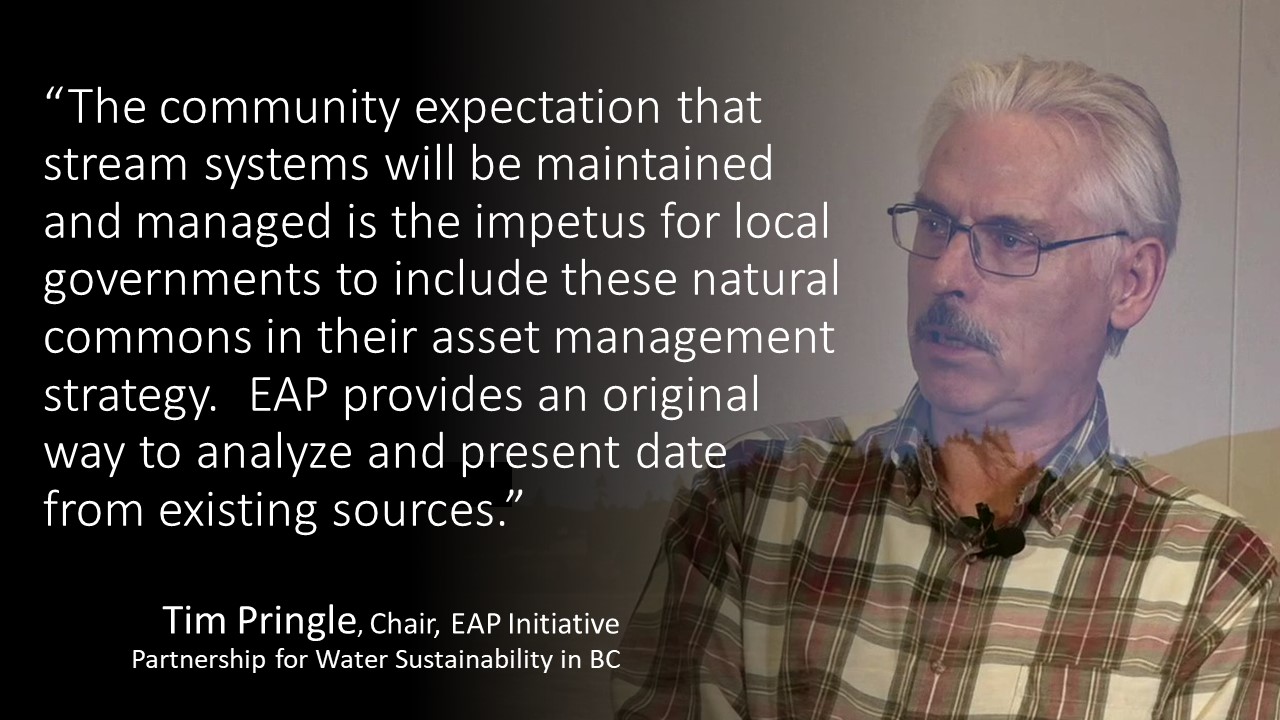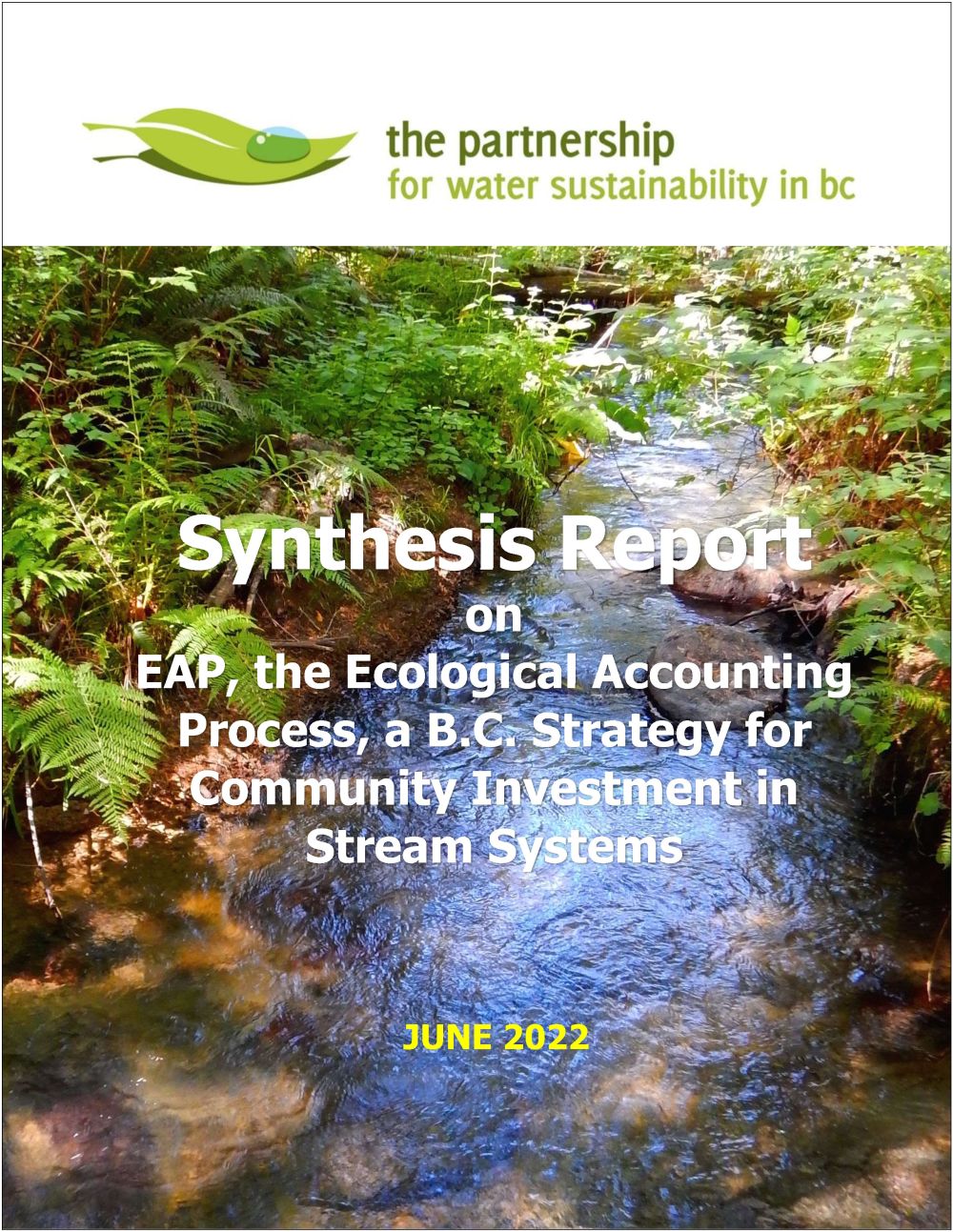19 BIG IDEAS POWER EAP: “The building blocks process of testing, refining and mainstreaming the methodology and metrics yielded 19 foundational concepts which we describe as big ideas,” stated Tim Pringle, EAP Chair
Note to Reader:
Thirteen local governments in five sub-regions of the Georgia Basin / Salish Sea Bioregion participated in the EAP program. The sequencing of the 9 case studies proved consequential and sometimes game changing. While the methodology and metrics are universal, each situation is unique. Understanding what each partner needed as an outcome from the project became a critical consideration in the building blocks process.

EAP makes financial case for investment in a stream system
“The EAP methodology refers to ‘accounting’ as taking stock of the social, ecological and financial (based on data from BC Assessment records) variables that describe a stream system from a land use point of view. The products of this work can be used for planning and budgeting annual investment to maintain (prevent degradation) and manage (restore and enhance) local stream systems,” explains Tim Pringle, Chair of EAP, the Ecological Accounting Process initiative led by the Partnership for Water Sustainability in British Columbia.
An overview of EAP metrics
“EAP metrics quantify the financial value of stream systems based on the area definition in the Riparian Areas Protection Regulation and as impacted by land use (human settlement).”
“EAP metrics quantify and describe riparian conditions in the setback zone and in the upland area extending 200m beyond the setback zone. These metrics apply to one or more sample areas that concern the local government and their collaborators involved in stream stewardship.”

EAP Building Blocks and Outcomes
“The Partnership for Water Sustainability completed nine case studies in the development and demonstration of the EAP methodology and metrics. Each case study involved one or more local governments and their stewardship collaborators in formulating the principal research questions and serving in advisory capacities,” explains Tim Pringle.
“EAP evolved as one big idea led to the next one,” adds Kim Stephens, Partnership Executive Director. “Tim Pringle and I could not have made the leap directly from the first to the last. It required a building blocks process. This is the beneficial outcome of the Partnership’s systematic approach to applied research that tested and refined the methodology and metrics to get them right.”
“The 19 big ideas are transformative in their implications for why and how local governments would implement Asset Management for Sustainable Drainage Service Delivery. Thus, a primary goal of the EAP program is to build support for the idea of operationalizing EAP as part of asset management practice in local government.”
To Learn More:
Click on the image below and/or download a copy of EAP Building Blocks in a Process.
Insights about making EAP effective – what communities need
Conversations with communities confirmed streams as the natural asset most in need of analysis.
All agreed that streams are a Natural Commons. Thus, a stream system ought to be comparable to other kinds of commons such as roads and drainage systems. Thus, EAP had to have a methodology to allow such comparison. The elements for analysis are:
A stream is a system and a Natural Commons.
The community uses and enjoys the services (habitat, drainage, recreation, and enjoyment of property) provided by the stream.
A stream has a regulated area defined by the Riparian Areas Protection Regulation
This area is a defined land use and must have a specific financial value.
The financial value of this area can be determined from BC Assessment data for parcels which abut the stream.
The extent of land use (subdivision and development) interference in the stream system is the Riparian Deficit.
To Learn More:
Download and read a copy of the entire Synthesis Report on EAP, the Ecological Accounting Process, A B.C. Strategy for Community Investment in Stream Systems (2022), the 4th in the Beyond the Guidebook series of guidance documents.
The Synthesis Report is a distillation of over 1000 pages of case study documentation into a storyline that is conversational and written for a continuum of audiences that includes land use practitioners, asset managers, stream stewards, and local government decision-makers.
Or, cut to the chase and read the 7-page extract titled Case Study Building Blocks Process.

DOWNLOAD A COPY OF https://waterbucket.ca/gi/wp-content/uploads/sites/4/2022/06/EAP-Synthesis-Report-Beyond-the-Guidebook-2022_Jun-2022.pdf


